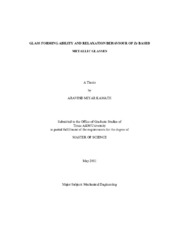Glass Forming Ability and Relaxation Behavior of Zr Based Metallic Glasses
Abstract
Metallic glasses can be considered for many commercial applications because of the higher mechanical strength, corrosion and wear resistance when compared to crystalline materials. To consider them for novel applications, the challenge of preparing metallic glasses from the liquid melt phase and how the properties of metallic glasses change due to relaxation need to be understood better. The glass forming ability (GFA) with variation in composition and inclusion of different alloying elements was studied by using thermal techniques to determine important GFA indicators for Zr-based bulk metallic glasses (BMG). The effect of alloying elements, annealing temperature and annealing time on the thermal and structural relaxation of the BMGs was studied by using an annealing induced relaxation approach. The thermal relaxation was studied by measuring specific heat of the samples using differential scanning calorimeter (DSC) and calculating the enthalpy recovery on reheating in the BMG samples. The structural relaxation was also studied by using extended X-ray absorption fine structure (EXAFS) technique on the as-obtained and relaxed samples. The effects of alloying elements and annealing on electrical resistance were studied by using a two point probe.
From the study, it was found that the currently used GFA indicators are inadequate to fully capture and identify the best GFA BMGs. The fragility (beta) of the melt is a new criterion that has been proposed to measure and analyze GFA. The enthalpy relaxation of Zrbased BMGs was found to follow a stretched exponential function, and the parameters obtained showed the BMGs used in the current study are strong glass formers. EXAFS studies showed variations in the structure of BMGs with changes in alloying elements. Furthermore, alloying elements were found to have an effect on the structure of the relaxed BMGs. The resistance of BMGs was found to decrease with relaxation which can be attributed to short range order on annealing.
Citation
Kamath, Aravind Miyar (2011). Glass Forming Ability and Relaxation Behavior of Zr Based Metallic Glasses. Master's thesis, Texas A&M University. Available electronically from https : / /hdl .handle .net /1969 .1 /ETD -TAMU -2011 -05 -9044.


